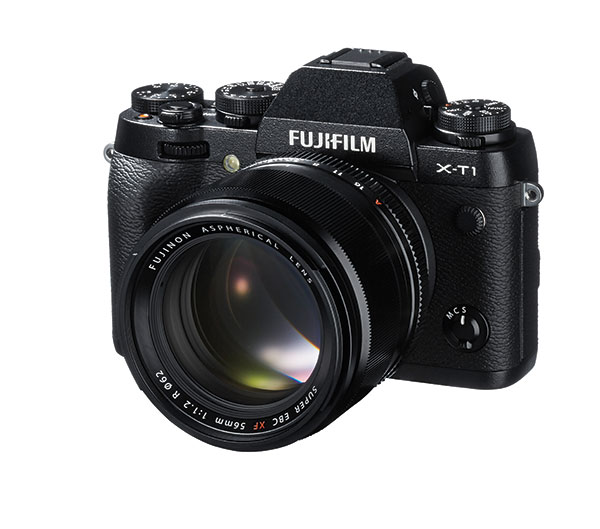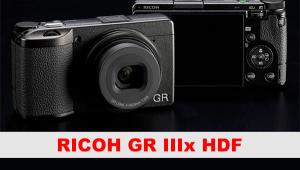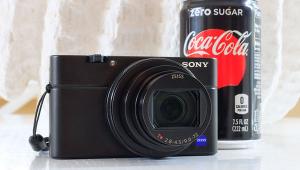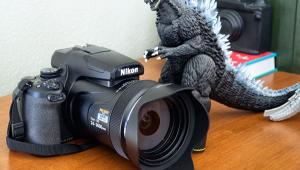Tough & Semi-Tough Cameras Get the Job Done: Neither Rain Nor Snow Nor Cold of Night Can Stop These Compact Shooters

Snowshoeing along a trail on a snowy day on Grouse Mountain, British Columbia, with a Fujifilm X-T1 along. Not the kinds of conditions into which you’re likely to bring your DSLR. Exposure was f/13 at 1/60 sec at ISO 320.
© George Schaub
One of the hottest categories these days are so-called “tough” cameras. They’re able to handle the elements on hikes and climbs made by hardy souls, are ideal for divers who want to record the wonders of the (fairly) deep, and are excellent choices for less arduous adventures, like a sunset stroll on a wind-blown Caribbean beach where a more delicate and expensive DSLR might be at risk. All can handle the rough and tumble of life where no mobile phone dares tread.
Then there are the semi-tough—mirrorless cameras that, while not as “armored” and sealed as the tough guys, can withstand a deep freeze or a downpour or a dust storm that might penetrate their more delicate cousins.
The aim of this roundup is to sample the numerous choices in ruggedized compact cameras, show you some of their cool designs, and give a hint as to what they offer. In our opinion everyone should have a tough guy ready to go along with whatever outdoor adventure one might have in mind. Owing to space limitations, we can only present a brief account of each camera: you’ll find more info on each manufacturer’s website, supplied at the end of the article. (Note: Focal lengths are given as 35mm equivalents.) You can head out on your next great adventure with any of these cameras knowing you won’t be returning with stories of the shot that got away, or the camera that got ruined by that sudden squall. Instead, you’ll return with the pictures of a lifetime. And with the camera intact.
Compacts
Canon PowerShot D30 ($329)
Submersible down to 82 feet, the deepest in this class, shockproof, freeze-proof, dustproof; GPS/geotagging; 12.1MP CMOS sensor; 5x optical (28-140mm) with optical IS; AF, face detection AF, AF tracking, manual focus; built-in flash; max. aperture: f/3.9 (W), f/4.8 (T); 15-1/1600 sec; still capture: auto, program, scene modes and effects (incl. underwater and UW macro, stitch-assist panorama); ISO: 100-3200; 1080/24p HD video; 3-inch TFT 461K LCD; battery life: 300 shots; 4.3x2.7x1.1 inches; 7.7 oz with battery.

Fujifilm FinePix XP70 ($229)
Submersible to 33 feet, shockproof, freeze-proof, dustproof; Wi-Fi wireless image transfer/geotagging; 16.4MP CMOS sensor; 5x optical (28-140mm) w/sensor-shift IS; AF, face detection; still capture: program AE, scene modes and effects (incl. UW/UW macro, HDR, motion panorama 360); built-in flash; max. aperture: f/3.9 (W), f/4.9 (T); 4-1/2000 sec; ISO: 100-3200, 6400 expanded; 1080/60i HD video; 2.7-inch TFT 460K LCD w/anti-reflection coating; 99MB internal memory; battery life: 210 shots; 4x2.6x1 inches; 6.3 oz with battery.

Olympus Stylus Tough TG-3 ($349)
Submersible to 50 feet, shockproof, crushproof, freeze-proof, dustproof; Wi-Fi remote operation/file sharing + GPS/geotagging + electronic compass; 16MP BSI CMOS sensor; 4x optical (25-100mm) w/sensor-shift IS; face detection AF, AF tracking; still capture: auto, program, aperture priority, microscope, scene modes and effects (incl. UW/UW macro, HDR, panorama), interval shooting, time-lapse; ISO: 100-6400, High; auto, preset, custom WB; built-in flash; max. aperture: f/2 (W), f/4.9 (T); shutter speed range: 4-1/2000 sec; 1080/60p HD video; 460K LCD; all SD-type cards plus 36MB internal memory; battery life: 380 shots; 4.4x2.6x1.2 inches; 8.7 oz.

Panasonic Lumix DMC-TS5 ($299)
Submersible to 43 feet, shockproof, crushproof, freeze-proof, dustproof; Wi-Fi/remote shooting/NFC + GPS/geotagging + electronic compass; 16.1MP MOS sensor; 4.6x optical (28-128mm) w/optical IS; face detection, AF tracking, 23-/one-area/spot AF; still capture: auto, program AE, manual, scene (incl. UW, HDR, panorama); auto-bracketing; built-in flash; max. aperture: f/3.3 (W), f/5.9 (T); 4-1/1300 sec; ISO: 100-3200, to 6400 expanded; 1080/60p HD video; 3-inch TFT 460K LCD; 10MB internal memory plus all SD-type cards; battery life: 370 shots; 4.3x2.6x1.1 inches; 7.5 oz with battery.

Ricoh WG-4 GPS ($376)
Submersible to 45 feet, shockproof, crushproof, freeze-proof, dustproof; GPS/geotagging + electronic compass; 16MP BSI CMOS sensor; 4x optical (25-100mm) with sensor-shift/electronic IS; nine-point/spot AF, AF tracking, manual focus, face detection; still capture: auto, program, shutter priority, scene modes and effects (incl. UW, digital microscope, HDR, panorama), interval shooting, time-lapse; auto-bracketing; built-in flash; max. aperture: f/2 (W), f/4.9 (T); 4-1/4000 sec; ISO: 125-1600, to 6400 expanded; 1080/30p HD video; 3-inch TFT 460K LCD w/anti-reflection coating; all SD cards plus 70MB internal memory; battery life: 240 shots; 4.9x2.5x1.3 inches; 8.3 oz with battery.

Sony Cyber-shot DSC-TX30 ($198)
Submersible to 33 feet, shockproof, freeze-proof, dustproof; 18.2MP Exmor R CMOS sensor; 5x optical (26-130mm) w/optical IS; AF (multi/center/spot), AF tracking, face detection; still capture: auto, program, scene modes and effects (incl. UW, HDR, panorama), magnifying glass plus; built-in flash; max. aperture: f/3.5 (W), f/4.8 (T); 4-1/1600 sec; ISO: 80-3200, 12,800 (expanded); 1080/60i HD video; 3.3-inch OLED (1229K) touch-panel monitor; microSD and all SD types, Memory Stick Micro; battery life: 250 shots; 3.8x2.3x0.6 inches; 4.9 oz with battery.

Compact System Cameras
For the most part, rugged mirrorless cameras are not built as tough as their point-and-shoot brethren, although the Nikon 1 AW1 did surprise us with its emulation (in a modest fashion) of the old Nikonos, and it’s shockproof. It’s the only submersible (with dedicated lenses ONLY) in the bunch. The others are sturdy and weatherproof, given the lens mount has the right seals. (Availability and range of these lenses varies.) Still, these cameras are competitors to other compact system cameras and to DSLRs of a more delicate breed, thus offer a bonus of rival image quality along with their “tougher” makeup.
One thing you’ll also note is that all these mirrorless cameras, but one, feature an electronic viewfinder (EVF) and LCD, that exception being the Nikon 1 AW1. Viewing and composition are relegated entirely to the monitor on the back of the AW1, which seems like a natural fit underwater.
Fujifilm X-T1 ($1299, body only)
Water-resistant, freeze-proof, dustproof, with reinforced LCD screen; Wi-Fi/remote operation/geotagging via Wi-Fi; APS-C-sized 16MP X-Trans CMOS II sensor; Fujifilm X mount (selected weather-resistant WR-series lenses available, with OIS), M mount adapter optional; auto-bracketing (AE, dynamic range, WB, ISO); dedicated hot shoe, compact external flash included; 30-1/4000 sec, Bulb, 1/180 sec or slower flash sync; ISO: 200-6400, 100 expanded, 12,800/25,600/51,200 expanded; 1080/60p HD video; 3-inch 1040K tilting LCD monitor; all SD types, including UHS-II; battery life: 350 frames; 5x3.5x1.8 inches; 15.4 oz with battery.

Nikon 1 AW1 ($799 w/11-27.5mm lens)
Submersible to 49 feet (with dedicated and sealed lenses, although all Nikon 1 system lenses mount), shockproof, freeze-proof, dustproof; Wi-Fi compatible (requires optional WU-1b Wireless Mobile Adapter), GPS/geotagging; 14.2MP CX-format CMOS sensor; Nikon Waterproof 1 lens mount (also usable but not waterproof: standard 1 Nikkors, AF-S Nikkors with adapter); built-in flash; 30-1/16,000 sec, Bulb, 1/60 sec flash sync and slower; ISO: 160-6400; 1080/60i HD video; 3-inch TFT LCD viewfinder/monitor; all SD card types plus UHS-I; battery life: 220 shots; 4.5x2.9x1.5 inches; 11.1 oz (body only).

Olympus OM-D E-M1 ($1399, body only)
Splashproof, freeze-proof, dustproof; Wi-Fi/remote operation/geotagging via Wi-Fi; 16MP Live MOS sensor; Micro Four Thirds lens mount; 2.36M EVF; auto-bracketing (AE, WB, ISO); dedicated hot shoe, compact external flash included; wireless flash control; 60-1/8000 sec, Bulb, 1/320 sec or slower flash sync; ISO: 100 (expanded)-25,600; 1080/30p HD video; 3-inch 1037K tilting touchscreen LCD; all SD card types plus UHS-I; battery life: 350 shots; 5.1x3.7x2.5 inches; 17.5 oz with battery.

Panasonic Lumix DMC-GH4 ($1699, body only)
Splashproof, dustproof; Wi-Fi/NFC/geotagging via Wi-Fi; 16MP Live MOS Sensor; Micro Four Thirds lens mount; OLED Live View Finder (2359K); auto-bracketing (AE, WB); built-in flash, dedicated hot shoe; 60-1/8000 sec, less than 1/250 sec flash sync, Bulb; ISO: 100 (expanded)-25,600; 4K video; monitor: articulated, touchscreen 3-inch OLED monitor (1036K); all SD card types; battery life: 500 shots; 5.23x3.68x3.30 inches; 19.75 oz with battery.

Sony Alpha A7 ($1698, body only)
Weather-resistant; Wi-Fi/NFC/remote control; 24.3MP full-frame Exmor CMOS sensor; E-mount (including weather-sealed, full-frame FE series; A-mount via optional adapter); 2.4M XGA OLED EVF; auto-bracketing (AE, WB, D-Range Optimizer); Multi-Interface Hot Shoe; 30-1/8000 sec, Bulb, 1/250 sec or slower flash sync; ISO: 50 (expanded)-25,600; 1080/60p HD video; tilting 3-inch (1229K) LCD monitor; Memory Stick PRO Duo/PRO-HG Duo/XC-HG Duo, all SD card types plus UHS-I; battery life: 340 shots; 5x3.7x1.9 inches; 16.7 oz with battery.

Terms Of The Trade
Weather-resistant: This indicates that a camera is sealed against both moisture and dust.
Waterproof: Will withstand rain (“splashproof”) or, when expressly stated, is submersible for a prescribed period of time, up to a maximum depth (adequate for snorkeling or even scuba diving), and even a drop in a snow bank when skiing or snowshoeing.
Shockproof: The camera’s ability to withstand a drop, usually tested onto a wooden floor from a height of around 6 to 7 feet.
Crushproof: A reinforced design to protect against someone sitting on it or getting crushed at the bottom of a backpack (tolerances are normally given as 220 lbf, or pound-feet).
Freeze-proof: Usable when you go sledding in Minnesota in mid-winter at temperatures below freezing (usually down to 14 degrees F) when the batteries in your “regular” camera might quit. Winter sports fans take note: you likely won’t have to worry about dropping it in the snow if it’s properly sealed.
All this toughness, however, comes at a slight inconvenience: routine maintenance to ensure all the seals remain intact and that the camera is rinsed free of corrosives after snorkeling or being dropped in the mud. Detailed instructions come with the camera and should be read thoroughly prior to use.
Important Features
Raw capture: Some cameras offer this, but many do not. If that’s important to you, lean more toward a mirrorless system camera.
Underwater capability: This capability varies slightly, with the Canon PowerShot D30, as of this writing, offering the deepest dive. Note: Submersion times are normally rated to one hour.
Wi-Fi and GPS: While both of these can be battery gobblers, Wi-Fi lets you communicate with other mobile devices and possibly even use of those devices to remotely control the camera. The Sony Cyber-shot TX30 is the only camera in this group without Wi-Fi or GPS support, while the Ricoh WG-4 offers GPS alone, but only in the designated model (featured in roundup).
Resolution: Most offer a very respectable 16MP, although that may vary so be aware.
Close-up lighting: Note that some cameras offer a small built-in flash; some even have a built-in LED for close-ups.
Card compatibility: All can handle SD/SDHC/SDXC cards. Most of the mirrorless camera models also take UHS-I or UHS-II cards.
Sensor: That varies, but all the way up to full frame.
Sources
Canon: www.usa.canon.com
Fujifilm: www.fujifilmusa.com
Nikon: www.nikonusa.com
Olympus: www.olympusamerica.com
Panasonic: www.panasonic.com
Ricoh: www.us.ricoh-imaging.com
Sony: www.sony.com
- Log in or register to post comments

















































